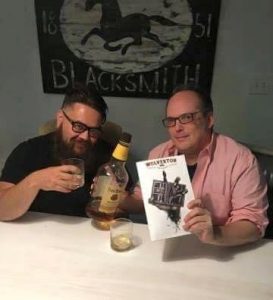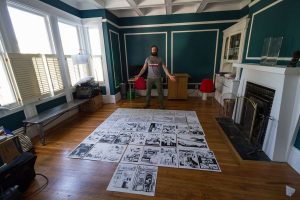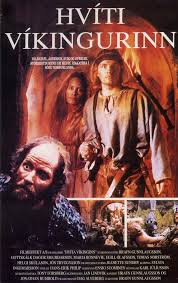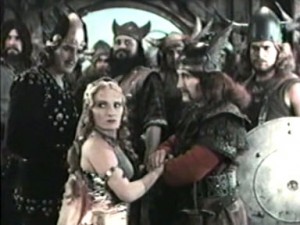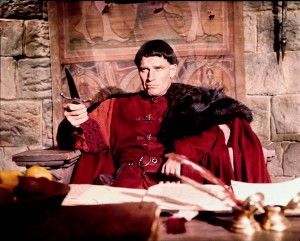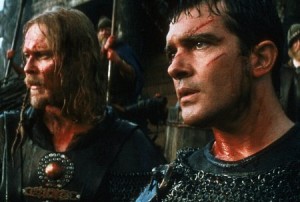 By Robert Emmett Murphy, Jr.
By Robert Emmett Murphy, Jr.
Special to ATLRetro.com
ABRAHAM LINCOLN: VAMPIRE HUNTER By Seth Grahame-Smith; Grand Central Publishing. 384 pages.
If the forecasts of the end of publishing as we know it, and the end of the novel as an important art form, prove correct, what will we be left with?
Well, one thing I note when I go into a bookstore is that though there’s not as much of what I personally want any more, there’s an ever growing abundance of at least one type of product. The product is remarkably adaptable to our all-too-instantaneous culture, and so deeply committed to vacillating fashions, that though the books are individually ephemeral, they are collectively eternal. I refer to novelty books.
Each is quickly produced, and just as quickly forgotten, yet the space they occupy is never empty. And if you return to that space over and over again, you will see that our impulsive and unconsidered consumption of facile distraction represents a continuum, demonstrating evidence of the hive mind and proof of a certain form of reincarnation. Moreover, within these novelties, maybe sometimes there is the possibility of a slightly substantive literature.
Both of Seth Grahame-Smith’s two most famous novels, PRIDE AND PREJUDICE WITH ZOMBIES and this one, ABRAHAM LINCOLN: VAMPIRE HUNTER, were commissioned for gimmicky series dreamed up by his editor at Grand Central Books. In both cases, he was the only novelist engaged who was able to play with the gimmicks (rewriting classics with monsters, reimagining historical figures with monsters) in a way that received significant positive critical attention. Grahame-Smith has a rare gift (or compulsion) to infuse some artistry to a throwaway idea. His literary career is distinguished by focusing on some ersatz absurdity, applying a sharper intelligence than many would think the subject deserves, and then keeping his one-note-joke buoyed by imaginative wit and exceptional attention to telling detail. He knows how the mechanisms of the B- and exploitation-movies make a narrative move, and he knows how to toss in just enough brain candy so that we don’t feel as guilty while reading his work as we did that time when Mom caught us flipping though the pages of a dirty magazine. (I should throw in, his first book was THE BIG BOOK OF PORN, a modestly seriously-minded history of the porn industry.) Here we have (as Gina McIntyre put it) “a great SATURDAY NIGHT LIVE sketch” transformed into a full-blooded, even epic novel.
In classic “high-concept” style (who the hell coined “high-concept”? It’s deliberating misleading as it inevitably targets the lowest common denominator!), the title says it all. I expected it to be fun, and it was, but I didn’t expect it to be as good as it was. And there in lies the rub – it was good enough to disappoint. When I saw what Graham-Smith was capable of doing, he raised my expectations, and then I found myself disappointed he didn’t do even more.
 No one reading ABRAHAM LINCOLN: VAMPIRE HUNTER is expecting either a real biography, or something comparable to the truly timeless historical novels like WAR AND PEACE. This is a populist fiction about a President we like a lot more in myth that reality. Rather than comparing this book to Doris Kearns Goodwin‘s TEAM OF RIVALS (the basis of the Steven Spielberg movie LINCOLN) or Leo Tolstoy, we are more in the territory of the movie YOUNG MR. LINCOLN, that sentimental piece of heliography that made Henry Fonda a star back in 1939 (directed by John Ford, written by Lamar Trotti).
No one reading ABRAHAM LINCOLN: VAMPIRE HUNTER is expecting either a real biography, or something comparable to the truly timeless historical novels like WAR AND PEACE. This is a populist fiction about a President we like a lot more in myth that reality. Rather than comparing this book to Doris Kearns Goodwin‘s TEAM OF RIVALS (the basis of the Steven Spielberg movie LINCOLN) or Leo Tolstoy, we are more in the territory of the movie YOUNG MR. LINCOLN, that sentimental piece of heliography that made Henry Fonda a star back in 1939 (directed by John Ford, written by Lamar Trotti).
Well, like YOUNG MR. LINCOLN, only with more a lot more blood and a much higher body count.
But then Grahame-Smith surprises us with a Lincoln who is many times more believable than Fonda’s. This Lincoln is strongly sympathetic, and though frequenting engaging in super-heroic antics, he’s neither a paragon of some ideal (Superman) nor an invitingly unoccupied vessel for the reader to fill with over-textural identification (most private eye heros). Clearly, Graham-Smith learned a few things from comic-book pioneer Stan Lee’s formula. In the past, Graham-Smith has collaborated with Lee, and here we see that the student far has excelled the master.
The novel begins in 2008, with a fictional version of Seth Grahame-Smith deep in a writer’s funk as he watches President Obama’s first inauguration. At this historically appropriate moment, he is offered a confusing, disturbing, perhaps dangerous, but also irresistible commission: to edit and flesh-out a long rumored of, but never made public diary which represents nothing short of a secret history of the Civil War, and by extension, America’s development and the whole of Western Civilization. You see, vampires are real, and the diary was Abraham Lincoln’s own record of his war against them.
The novel that follows switches back and forth between Lincoln’s secret dairies, which are, of course, fiction, woven seamlessly in with Lincoln’s letters, which are real, and Grahame-Smith’s omniscient third-person narrative, which is based on the testimony of surviving (undead) witnesses and a great deal of material pulled directly from more respectable historical sources.
 The novel starts in Lincoln’s childhood and shows his development in a rich and thoughtful in a way that too little genre fiction has much patience for. Deftly sketched is Lincoln’s complicated family tree, the challenges of his humble beginnings, his strained relationship with his father, his enormous personal drive, his insatiable intellectual curiosity, and how his life’s trajectories were guided by a series of early tragic losses and economic reversals. Lincoln’s famous battle with depression is woven throughout the book, but treated with an appropriately light touch, because Grahame-Smith instinctively knows that had the depression truly been crippling, Lincoln would’ve never become Lincoln. It is somewhat removed from the “cult of Lincoln” of popular myth and somewhat closer to a figure historians would recognize.
The novel starts in Lincoln’s childhood and shows his development in a rich and thoughtful in a way that too little genre fiction has much patience for. Deftly sketched is Lincoln’s complicated family tree, the challenges of his humble beginnings, his strained relationship with his father, his enormous personal drive, his insatiable intellectual curiosity, and how his life’s trajectories were guided by a series of early tragic losses and economic reversals. Lincoln’s famous battle with depression is woven throughout the book, but treated with an appropriately light touch, because Grahame-Smith instinctively knows that had the depression truly been crippling, Lincoln would’ve never become Lincoln. It is somewhat removed from the “cult of Lincoln” of popular myth and somewhat closer to a figure historians would recognize.
At least up to a point.
The “up to a point” part is the crux of the novel, because in 1820 Lincoln realizes his life is being shaped by the capricious whim and insatiable hunger of supernatural entities that are stronger, faster, more experienced and more skillful than he. In 1820, he launches a one-man covert-war against their evil.
The novel is at its strongest when addressing Lincoln’s early days. Rich in the biographical detail of years that many, even Civil War buffs, are not fully familiar with, this part of Lincoln’s life is the era in which this kind of keyhole narrative can most easily be integrated into historical realities. The young Lincoln rambled widely, living and working in several states and trying out several professions, giving any adept writer abundant opportunity to paint the landscape vividly and imaginatively and still remain in the context of the verifiable. When Grahame-Smith puts words in his fictional Lincoln’s mouth, he displays a fluid style that is often lacking in like-pastiches, for example, when the diary recounts what Lincoln witnessed at a slave auction:
“I saw a Negro girl of three or four clinging to her mother, confused as to why she was dressed in such clothes; why she had been scrubbed the night before; made to stand on this platform while men shouted numbers and waved pieces of paper in the air. Again I wondered why a Creator who had dreamt such beauty would have slandered it with such evil.”
By this point in the narrative, Lincoln has already allied himself with a group of not-so-evil vampires who call themselves the “Union” – get it? – against the other more powerful group who dominated Southern politics and society. His political career which would start not long after and be shaped by that association. The contrasts in which the story revels rest on this foundation, largely historical content vs. horror-movie scares and comic-book action scenes.
 The horror/action content is fast- paced, hugely entraining and often quite funny. In one episode, Lincoln, now a lawyer, is bruised in court with the loss of a civil suit; that evening he goes out on a vampire hunt. To his surprise, it turns out that evening’s monster is none other than his client from earlier in the day. Just as they are about engage in their death duel, the demoness hisses contemptuously that Lincoln better hope that he’s a better fighter than an attorney.
The horror/action content is fast- paced, hugely entraining and often quite funny. In one episode, Lincoln, now a lawyer, is bruised in court with the loss of a civil suit; that evening he goes out on a vampire hunt. To his surprise, it turns out that evening’s monster is none other than his client from earlier in the day. Just as they are about engage in their death duel, the demoness hisses contemptuously that Lincoln better hope that he’s a better fighter than an attorney.
Grahame-Smith’s historical fidelity grants his hero a more interesting character arc than most pulp heroes. When this fictional Lincoln, mimicking the real one, falls in love, marries, has children and enters politics, he does something few action heroes ever do, but most men of accomplishment accept as an inevitability. He puts aside childish things (in this case, his axe) and creates a more stable and sustainable life, integrating himself into new venues, and pondering how he can apply the lessons of his youth to the realities of maturity.
This radical turn in the narrative allows the pulp novel to be shaped by more-complex-than-average relationships. Lincoln profoundly loves his wife, who is treated with a lot more respect here than in most dramatizations of Lincoln’s life, but still he turns his back on her in her hour of greatest need. After losing a second child, she spirals into mental instability, but by then he is President and in the midst of the ultimate national crisis. I also liked the handling of his long-rivalry, and occasional allegiance, with Stephen Douglas, who in most Lincoln dramas is regulated to a single footnote incident.
The novel leans heavily on mano-a-mano combat up to this point, and as the more complex history unfolds, Grahame-Smith repeatedly interrupts it with more breathless action-episodes. During the build-up to the Civil War, the retired vampire hunter reluctantly accepts one last vital mission from his Union allies.
So the hero’s reluctantly dragged out of retirement for one last vital mission. Yeah, we all know how well those generally work out, don’t we?
This situation leads to a wild scene where Lincoln and his two assistant vampire hunters, Joshua Speed and Jack Armstrong (both historical characters), are hopelessly trapped in a burning plantation-manor-house, surrounded by an army of vampires, while Jefferson Davis, in classic melodramatic villain style, gives a smug speech about the superiority of his cravenness over Abe’s naive virtues. It would not have been out of place in the recent film DJANGO UNCHAINED.
As entertaining as all this interplay is, it also is evidence of the difficulties of taking a story that was one thing and trying to mutate into another into another. This problem is demonstrated even in the number of pages the book devotes to this subject or that. A full 187 pages are required to get us to the year 1843, when Lincoln hangs up his axe. After that, a mere 146 pages is left to get him into Congress, then the White House, guide the nation through the Civil War, and fall to an assassin’s bullet (by the way, John Wilkes Booth was a vampire).

Joshua Speed.
However, Graham-Smith, making vampires the primary drivers of the slave economy and the secret force behind the South’s mad, headlong rush into war, has stumbled across a near perfect metaphor. Vampires, since Dracula, have represented hold-over superstitions trying to keep the shadows deep and dark in the face of the light of reason and modernity, and they are simultaneously the aristocracy and the parasite. They have been exploited to make political points not only in fiction but presidential campaign rhetoric (anyone remember the “Romney is a Vampire” TV ad?). The metaphor has rarely been utilized as forcefully as here, but unfortunately it isn’t used to dig as deep as it could. Having set the stage so deftly, Graham-Smith fails to utilize his fantasy to illuminate real themes in history as historical fictions are generally expected to do.
One thing almost every Lincoln drama gets wrong is how slowly his positions on slavery evolved. From his earliest years, he found slavery morally repugnant, and his abolitionist rhetoric was fiery in even his earliest political speeches. But even well into the Civil War, his policies regarding the institution were, in fact, quite moderate (and from a 21st century perspective, reprehensible). Preservation of the Union was his number one priority, freeing the slaves was way down the list. It would not be much of a stretch to say he’d have been satisfied to institute a handful of reforms that maybe could have been utilized by others later, and that he was okay with the possibility that the end of slavery was something he didn’t personally live to see.
The first step in seeing someone as human is fully recognizing them as real. There’s little reason to think that black slaves, who did move Lincoln’s heart when he saw them suffer from a distance, were ever close enough to him that he was forced to see them as real as his friends and associates, or even as real as his bitter enemies. There’s little or no record of Lincoln having substantive encounters with blacks during his formative years in rural Kentucky. Working on a flat boat on the Mississippi, he wasn’t likely to be invited into the homes of slave owners, nor to encounter the minority of black freemen in his day-to-day labors. Though Lincoln married the daughter of a prominent slave-holder, he was not close to his in-laws, and he and his wife settled in a free state. I’d wager that it’s not likely he had a conversation with a black person longer than 10 words before went to Washington in 1846, maybe not until he entered the White House in 1861, and maybe not even until his memorable meeting with Frederick Douglass in 1863 (which isn’t included in this particular book).
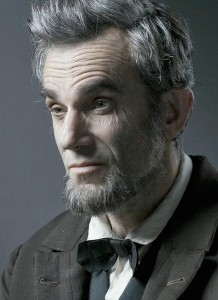
Daniel Day Lewis as Abraham Lincoln in Stephen Spielberg's LINCOLN. Dreamworks/20th Century Fox, 2012.
Moreover, not only was Lincoln not a liberal by today’s standards, he was a man of a time when it would’ve been almost overwhelming intellectually challenging to conceive of blacks as fully of the same species as whites. He was quite articulate in expressing his belief that blacks were inferior to whites. Lincoln’s moral evolution was a long road that most dramatists don’t want to admit he had to travel. Nor do they want to acknowledge that his eventual abandonment of comfortable, if reprehensible, moderation and his heroic embrace of a righteous stand was something that he was burdened with, in part, by the Confederate madness.
ABRAHAM LINCOLN: VAMPIRE HUNTER doesn’t misrepresent Lincoln’s relationship with slavery, but having built so a fine bridge of fantasy to this true subject, it side-steps it rather than crossing it.
The novel is better in evoking the madness and hopeless of the Southern cause, but even here I find fault. We see the relentless spiral towards war through Lincoln’s eyes in the first-person entries. But Graham-Smith also availed himself of the third person omniscient, yet didn’t utilize it when it was most needed. It should’ve been said that the South had a smaller population, a limited industrial base, and significantly no cannon factories. The Confederate strategy was to strike first in the months between the election and inauguration and then dig in so that the Federal Government couldn’t respond. When Lincoln chose the course of military engagement, the South inevitably was doomed. Yet almost four years and more than 600,000 lives were forfeited to this pointless exercise. Even to that last moment, the firing on Fort Sumter – hell, even after that last moment – the South had so many other options, but they acted with the kind of irrational absolutism that we now associate with only the maddest of despots or the presumptuousness of the divine (read: supernatural) right of kings.
According to a 1973 study by Harvard economist Claudia Goldin, had the South ended the institution of slavery by buying and freeing all the slaves instead of going to war, it would’ve cost them about $2.7 billion 1861 dollars. True, it is hard to imagine the political will to execute such a plan could’ve ever been mustered, but what were the costs of turning their collective backs on any compromise or accommodation? On the Southern side alone, the most often-cited figures are $1 billion in property destruction, $1.5 billion in loss of human capital, $767 million for war expenditures, and an appalling 258,000 dead young men. To this, Goldin added a net economic difference of $10 billion between an imaginary South without rebellion and the one we got, in which wide regions wallowed in near continuous recession for the next 80 years. This is the kind of clarifying extra that the fictional narrator Graham-Smith could have provided us with, but that the fictional diarist Lincoln couldn’t have been reasonably expected to.
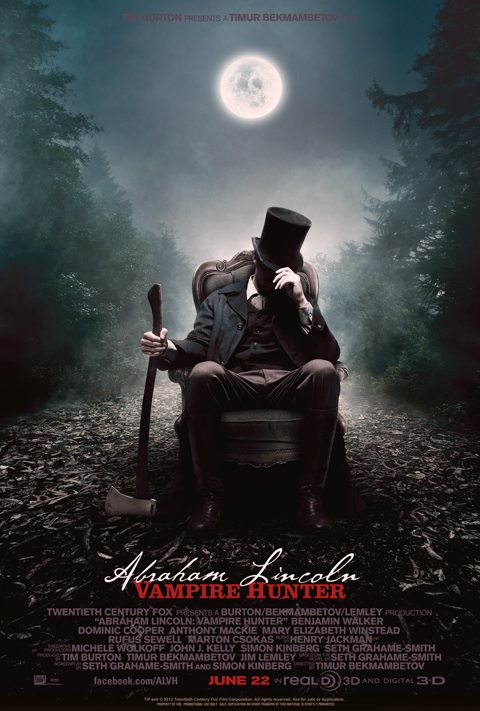
Poster art for the movie of ABRAHAM LINCOLN: VAMPIRE HUNTER (2012).
And not for nothing, the real Lincoln, who couldn’t have done Goldin’s math, wasn’t insensitive to the idea. In an 1862 letter Lincoln wrote, “Less than one half-day’s cost of this war would pay for all the slaves in Delaware at $400 per head … [and] less than 87 days’ cost of the war would, at the same price, pay for all in Delaware, Maryland, District of Columbia, Kentucky and Missouri.” (This letter is not cited in this particular book.) In fact the Federal government did buy back the slaves within the confines of the District of Columbia. (This fact is also not cited in this particular book.)
Once the war starts, the novel engages the reader mostly because of its effective and exciting compression of what actually happened, while the vampire metaphor, suddenly under-exploited and under-explored, loses much of it bite (pardon the pun). Lev Grossman puts it well in TIME Magazine, “Once the connection is made, it feels obvious, and neither slavery nor vampirism reveals anything in particular about the other. One could imagine a richer, subtler treatment of the subject, in which the two horrors multiply each other rather than cancel each other out.”
Yet as Lincoln fictions go, ABRAHAM LINCOLN: VAMPIRE HUNTER has more to say than most. Maybe it communicates something about our culture that a deliberately ridiculous, axe-wielding, vigilante super-hero towers over most more easily respected works. Allegedly realistic fictions have been full of myth, while the myth-shaped novel presents a sharper picture. One measure in how the novel succeeds is revealed in a words of a withering critique of the Timur Bekmambetov’s film based on this novel. Historian Vernon Burton enjoyed the book but hated the movie, and spoke volumes of the pitfalls of fictions that prove incapable of grasping the real historical issues they grapple with (from an article by Tierney Sneed in US News and World Report):
“‘Slavery was our national sin,’ said Burton, who said the connection works in that ‘the nation sucked the blood out of Africans for its wealth.’ However, in posing vampires as the villains behind the crime of slavery, the film risks ‘letting the South and the United States off,’ freeing it from blame for the practice.
‘The book did some clever things,’ said Burton. ‘I was excited to see the movie. The book had potential.’ He said the film version was oversimplified, and he worried viewers would make too much of what he and other historians often call the ‘Oliver Stone school of history.’”
That, at least, is one trap the novel didn’t fall into.
Robert Murphy is 47 years old and lives in New York City. Formerly employed, he now has plenty of time to write about movies and books and play with his cats.

 ISHIRO HONDA DOUBLE FEATURE: THE H-MAN & BATTLE IN OUTER SPACE (1958-59)
ISHIRO HONDA DOUBLE FEATURE: THE H-MAN & BATTLE IN OUTER SPACE (1958-59) series.
series. much of the American sci-fi cinema of the time, the model work here is of the highest quality and the recipient of Koizumi’s deep, colorful lighting, making it stand above the pack. Strip-mined for premise as well as art direction by Gerry and Sylvia Anderson’s CAPTAIN SCARLET AND THE MYSTERONS (1967) television series, the film is honestly a joy visually, but suffers a similar fate as THE H-MAN when the second act unfolds. Both films are stuffed with what author and film commentator David J. Schow calls “shoe leather;” unnecessarily long shots of mundane action, dialog that could easily be excised, etc. Essentially, padding to expand the running time of the film which adds nothing to the viewing experience. BATTLE IN OUTER SPACE does accelerate once the U.N. forces reach the moon and attack the alien base there, however.
much of the American sci-fi cinema of the time, the model work here is of the highest quality and the recipient of Koizumi’s deep, colorful lighting, making it stand above the pack. Strip-mined for premise as well as art direction by Gerry and Sylvia Anderson’s CAPTAIN SCARLET AND THE MYSTERONS (1967) television series, the film is honestly a joy visually, but suffers a similar fate as THE H-MAN when the second act unfolds. Both films are stuffed with what author and film commentator David J. Schow calls “shoe leather;” unnecessarily long shots of mundane action, dialog that could easily be excised, etc. Essentially, padding to expand the running time of the film which adds nothing to the viewing experience. BATTLE IN OUTER SPACE does accelerate once the U.N. forces reach the moon and attack the alien base there, however. MISTER ROBERTS – 1955
MISTER ROBERTS – 1955 constant odds with his Captain (Cagney in bravura performance of pure, hilarious evil), Roberts takes solace in his relationship with Powell’s Doc, a sympathetic veteran too tired to complain any longer, and his bunkmate, Ensign Frank Pulver (Lemmon), a braggadocious schemer who never quite follows through on his plans. Executive officer of the boat, Roberts is also popular with the crew for his passive-aggressive war with the Captain, who terrorizes them regularly.
constant odds with his Captain (Cagney in bravura performance of pure, hilarious evil), Roberts takes solace in his relationship with Powell’s Doc, a sympathetic veteran too tired to complain any longer, and his bunkmate, Ensign Frank Pulver (Lemmon), a braggadocious schemer who never quite follows through on his plans. Executive officer of the boat, Roberts is also popular with the crew for his passive-aggressive war with the Captain, who terrorizes them regularly. midtone range. The only flaws I saw were minimal focus issues near the vertical screen edges occasionally, artifacts of the original CinemaScope projection process most likely. Sound is also above expectation, and a real joy in 24-bit 5.1 surround. Extras include the original theatrical trailer and a scene-specific audio commentary by Jack Lemmon, carried over from a previous release.
midtone range. The only flaws I saw were minimal focus issues near the vertical screen edges occasionally, artifacts of the original CinemaScope projection process most likely. Sound is also above expectation, and a real joy in 24-bit 5.1 surround. Extras include the original theatrical trailer and a scene-specific audio commentary by Jack Lemmon, carried over from a previous release.

